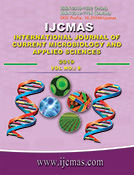


 National Academy of Agricultural Sciences (NAAS)
National Academy of Agricultural Sciences (NAAS)

|
PRINT ISSN : 2319-7692
Online ISSN : 2319-7706 Issues : 12 per year Publisher : Excellent Publishers Email : editorijcmas@gmail.com / submit@ijcmas.com Editor-in-chief: Dr.M.Prakash Index Copernicus ICV 2018: 95.39 NAAS RATING 2020: 5.38 |
F2 Population obtained from F1 cross between Tulasi (Most tolerant genotype) and CUL-8709 (Most susceptible genotype). 300F2 plants and their parents were screened at 800 ppm of Fe. Phenotyping screening of F2 plants under iron toxic levels indicated that leaf bronzing is associated with growth reduction due to Fe2+ toxicity in this F2 population confirms the usefulness of leaf bronzing index as criterion for differentiating between genotypes susceptible and tolerance to iron toxicity. This typical symptom of Fe toxicity, showed a strong negative correlation with shoot length, root length, total number of roots, number of fresh roots, shoot weight and root weight. Iron reversibly adsorbed on root surface was positively correlated with iron content in the root and observed in plants with lower leaf bronzing symptoms indicated that physiological mechanisms like Fe exclusion from roots and root tissue tolerance at higher Fe content in roots are predominant in Fe toxicity tolerance.
 |
 |
 |
 |
 |